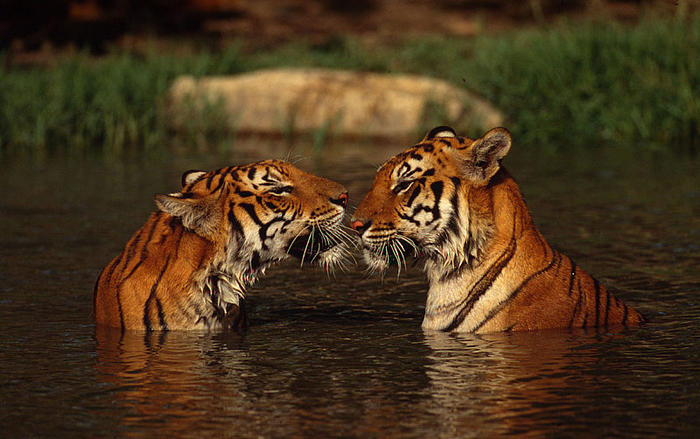Watershed week for tigers around the world
Next week may be make-or-break for the future of wild tigers around the world.
Russian Prime Minister Vladimir Putin will be hosting delegations from tiger-range countries for the first ever International Tiger Summit in Saint Petersburg.

Heads of state from 13 tiger-range countries plus a high-level delegation from the United States will gather to discuss responses to the alarming decline of tiger populations in the wild. What all parties can agree with going in, is that inaction will inevitably lead to the extinction of this beautiful creature, one of the world's most beloved.
First, here are some statistics on wild tigers. The estimated population in the wild today is a mere 3,200, down from hundreds of thousands a century ago. They live in only four percent of their former habitat. Of the nine subspecies of tiger, three have already gone extinct. Demand for tiger parts has fueled poaching and black market trade across international borders. At this moment, there are more tigers locked up in zoos and backyards in the United States than are in the wild.
Wildlife advocacy groups like the World Wildlife Fund and TRAFFIC International have stepped up efforts to ensure that a binding agreement is made at the upcoming summit. Among those most active is Mike Baltzer, Head of WWF's Tiger Alive Initiative. According to Baltzer, conservationists "know what it takes to save tigers, but we need financing mechanisms and consistent injection of funds to support action." We need government commitments. He added, "We need immediate action and need to sustain that action." If not, we will find ourselves in the same place years from now. The summit in Russia is pivotal in securing both financial support and political will.
Also involved is the World Bank's Global Tiger Initiative which has pledged help in financing programs that would boost local public support for tiger conservation and reduce the illegal trade in tiger parts. This initiative is a major sponsor of the International Tiger Summit.
On the agenda at the summit will be the Global Tiger Recovery Program. A draft document was written in July, 2010 at the pre-Tiger Summit meeting in Bali. The goal is to double the number of tigers in the wild in twelve years. To start, emergency funding is required to protect the last refuges for tigers, but the ultimate goal is not just conservation but expansion.
On a media conference call yesterday, Barney Long, manager of the Tiger Program at WWF-US, said "there is hope for tigers. We can look at the past to see what works." For example, in eastern Russia, conservation efforts have increased the numbers of endangered Amur tigers from 40 to 450. Authorities in Nepal have designated wildlife corridors to allow the tiger a freer range.
In Cambodia, increased law enforcement has dramatically increased the numbers of tigers and other wildlife since 2000. WWF has pledged its support to protect tigers and tiger prey in these most critical areas. Eventually, that protection will expand to 125 areas around the world.
All these examples had two things in common: political will and financial support. For tigers to recover on a global scale, that support must be maintained range-wide across the nations of Asia. If nothing is done, illegal poaching will continue to flourish and tigers will be wiped out. Hopefully, the International Tiger Summit will set wild tigers on the road to recovery.
Special coverage:? Save the tigers, save the planet
 0
0 






